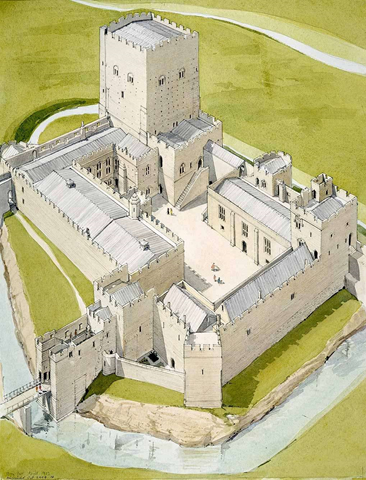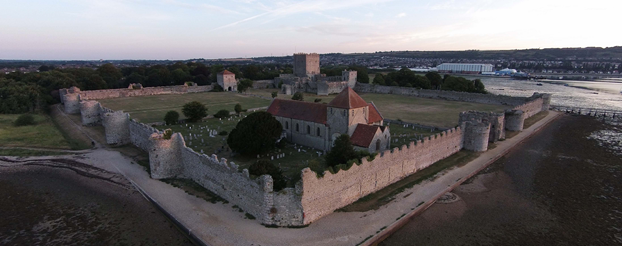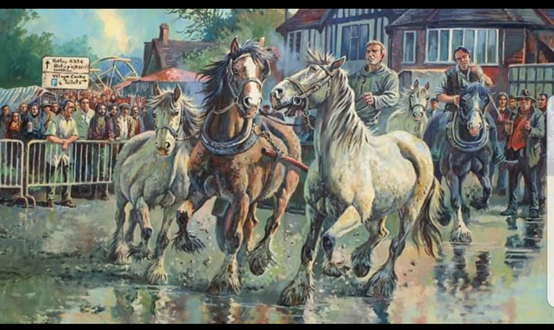Portchester Castle was begun as a Roman fort, one of the series of coastal forts now known as the Forts of the Saxon Shore. These forts were built over the course of the 3rd century, to meet the threat presented by Saxon pirates who were then raiding the south coast of Roman Britain.
It seems clear that the fort was founded on this area because of its commanding position at the head of a huge natural harbour. There is no clear evidence for the date of the original fort, but coins recently found on the site date it to after about 268 AD (Cunliffe,1975).
The castle’s commanding location has made it a major factor in the Solent’s defences for hundreds of years. Make the most of the wide-open grounds and castle courtyard, and enjoy a family picnic surrounded by history.
Portchester was abandoned in the early fifth century when the Romans withdrew from Britain as, without the presence of the navy nor deliveries from the Imperial supply chain, it simply ceased to have a function. Archaeological evidence suggests some form of occupation continued and by the tenth century a high-status hall seems to have been established within the site. However, in AD 904 the site was converted into a burh (fortified town) by King Edward the Elder who spent £1,100 repairing and reinforcing Portchester Castle.
Archaeologists have found evidence of successive generations of timber buildings from the Anglo-Saxon period within the fort’s walls. In the 10th century a large hall, a courtyard and a stone tower were built within the fort. This suggests that an important man and his family lived here. A small cemetery was also found.
Portchester Castle was taken into Crown control in 1154 by Henry II. He spent modest sums enhancing the accommodation and regularly used these facilities as he travelled to and from the continent.
During the Hundred Years War, Portchester became a marshalling ground for troops departing to fight in France.
Portchester Castle was first used to house captured enemy soldiers in 1665, when England was at war with the Netherlands. The government rented the castle from its owners and housed about 500 Dutch prisoners here. It was used as a prison again during all the major wars of the 18th century, mainly to house French captives. During the War of Austrian Succession (1740–48) Portchester housed around 2,500 prisoners – about a quarter of all the prisoners of war in Britain.
Prisoners of many different nationalities and backgrounds were brought to Portchester in the course of the wars. A group of about 2,000 mainly black and mixed-race prisoners were brought to the castle from the Caribbean in 1796, and remained at Portchester for over a year. Later, a number of prisoners who were among a large group of French captives brought here from the Mediterranean in 1810 transformed one of the rooms in the keep into a theatre. The last prisoners left the castle in May 1814.
After the prisoners left, the army abandoned the castle, and returned it to its owners, the Thistlethwayte family, in 1819.
Then, in the 19th century the castle became a tourist attraction, and housed a ‘pleasure garden’, a place of entertainment. At some point in the early 19th century another theatre was established in the keep, but this was on the second floor, two storeys above the room where the French prisoners’ theatre had been. Traces of its painted decoration survive.
Between 1961 and 1979 the castle was the scene of major archaeological excavations directed by Professor Barry Cunliffe. These have transformed our understanding of its long history.
The excavations produced thousands of finds, ranging from prehistoric times to the 19th century. Geophysical survey – which collects information on hidden features without the need for excavation – revealed the presence of many buried features, including the sites of the timber buildings that housed the prisoners of war in the late 18th and early 19th centuries.

References:
- B Cunliffe, Excavations at Portchester Castle, Volume I: Roman, Society of Antiquaries Research Report 32 (London, 1975).
- B Cunliffe, Excavations at Portchester Castle, Volume 2: Saxon, Society of Antiquaries Research Report 33 (London, 1976).
- A Williams, ‘A bell house and a burh-geat: lordly residences in England before the Conquest’, in Anglo-Norman Castles, ed R Liddiard (Woodbridge, 2003), 23–8.
Written by: Venia Soumpenioti



